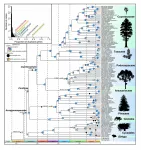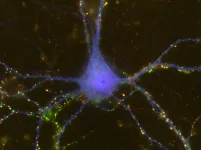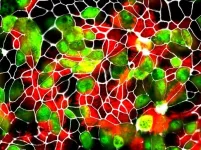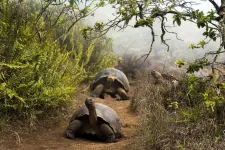Between 2004 and 2018, changing climate at the monarch's spring and summer breeding grounds has had the most significant impact on this declining population. In fact, the effects of climate change have been nearly seven times more significant than other contributors, such as habitat loss. The team published its report July 19 in the journal Nature Ecology & Evolution.
"What we do is develop models to understand why monarchs are declining and what's happening to biodiversity in general," said Erin Zylstra, the study's lead author. Zylstra is a postdoctoral researcher in the Department of Integrative Biology and the Ecology, Evolution and Behavior Program, both in MSU's College of Natural Science.
"A lot of it is not good news. But in understanding the reasons why a species is declining, there is also a message of hope: there's something we can do about it," said Zylstra. "We did this study not just to say what's causing changes in the monarch butterfly population, but also learn how we can make it better."
Understanding the monarch decline and doing what we can to reverse it is important not just for preserving biodiversity, but also because insects are prolific pollinators. The eastern population of monarchs migrates between Mexico and the eastern half of the U.S. and southern Canada every year -- with summer layovers in Michigan and other U.S. states. Since the mid-1990s, though, there has been a dramatic decline in their population, with worst-case estimates projecting that the current population is a mere 20% of what it was just a few decades ago.
The mid-1990s through the mid-2000s saw the most dramatic decline, coinciding with a period when glyphosate weed killers became hugely popular in the agricultural industry. Farmers grew crops that were engineered to be resistant to glyphosate, allowing them to apply the chemical widely, decimating milkweed plants that are the sole host and food source for monarch caterpillars.
The prevailing theory during that period has been that the loss of milkweed from agricultural areas was responsible for the severe declines. Since then, monarch populations have continued to fall. Although glyphosate-driven milkweed loss remained one possible explanation, other theories emerged over time. Today, researchers are divided on what's stunting the monarch's population.
About a decade ago, however, Leslie Ries of Georgetown University and Elise Zipkin, now an associate professor of integrative biology at MSU, came to a realization. Researchers and volunteers were collecting an increasing amount of data that could help make a more definitive determination of what's driving the monarch population decline.
"People have different hypotheses," said Zipkin, the senior author on the new study and director of the Ecology, Evolution and Behavior Program. "So we tried to come in as an impartial team, take the time and put all these pieces together to really parse out the contributions of various stressors."
Part of what makes it so difficult to understand the decline is the eastern monarch's complicated life cycle. These monarchs spend their winters, November through February, in central Mexico. When the weather starts to warm, they head north to the southeastern U.S., particularly eastern Texas.
Once there, the adults breed, lay eggs and then die. It's the next generation that continues the migration, starting in about May, flying to the Midwest and parts of Canada, where they produce two to three more generations. The butterflies that develop in late August shut down their reproductive systems and spend their energy migrating south back to Mexico, where the cycle begins anew.
With support from the National Science Foundation, the team analyzed data from more than 18,000 surveys of monarchs in different locations across the midwestern U.S., central Mexico and southern Canada between 1994 and 2018. Most of these surveys were performed by local volunteers who helped count adult butterflies.
"Almost all of those data were not collected by professional scientists and that is really, really cool," Zipkin said. "There is no group of scientists out there that could collect all the data that we needed. But these volunteers go out every year and record data in a very structured way. That's the only way we could do this analysis."
"The level of expertise among the volunteers is really incredible," said Zylstra.
Zylstra led the effort to develop a model based on these observations and draw meaningful conclusions. In particular, the team was interested in what the data said about the three leading theories behind the eastern monarch's population decline: milkweed habitat loss, mortality during the autumn migration and resettlement on the overwintering grounds, and climate change's detrimental impact on monarch breeding success.
"I think that everyone is partially right. All of these things do play some role. With monarchs, everything is nuanced, and everything is tricky," said Zylstra. "But in recent years, as glyphosate applications have remained more stable, although still very high, there is strong evidence that population changes are driven by climate on the spring and summer breeding grounds."
Each of these hypotheses can contribute to lost butterflies at smaller scales, Zylstra explained. But looking at the problem holistically -- across many years and multiple countries -- makes it clear that climate change has been the dominant disruptive force since 2004. Unfortunately, there isn't enough data in agricultural regions to definitively determine what happened between the mid-1990s and the mid-2000s, the period of the most pronounced decline.
To get the full picture of the population decline, the team needed to understand the dynamics of many generations in many locations. Hence the need for thousands upon thousands of surveys. The herculean effort of collecting and making sense of this data has also reaped two large rewards.
First, by proving the model's potential to tease out population dynamics for something as complicated as the eastern monarch, the team is optimistic it can adapt the model to understand what's driving population changes in other species, too.
Secondly, this understanding should help inform where conservation efforts can provide the greatest benefit for the eastern monarch's numbers.
"This study gives us information on where to spend our limited dollars on restoration," Zylstra said.
Although we can't simply turn off climate change, we can, for example, focus on restoring milkweed in the regions that remain most conducive to monarch reproduction despite warming temperatures and shifting precipitation patterns, she said. That said, anything we can do to curb climate change will also improve the outlook for both monarchs and humanity, she added.
And although curbing climate change is a huge lift, Zipkin pointed out that this study reminds us of the power of partnerships to confront large challenges.
"We're talking about three countries that this is directly affecting: the U.S., Canada and Mexico. It's not something that we have to do alone," Zipkin said. "Partnerships do matter."
Working out what's behind the population decline proved that. Between the professional scientists and volunteer data collectors, residents of all three countries made this study possible.
"You need those kinds of partnerships. You need people with different expertise. We showed that's how we can figure out what's going on. Now, what can we do with conservation?" Zipkin asked. "We can work together."
INFORMATION:



